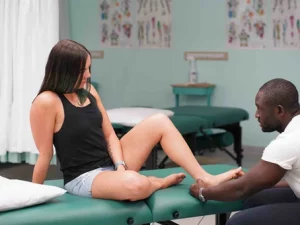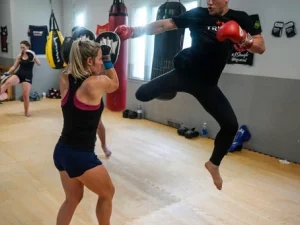
If you’ve ever walked into a gym or watched pro sports, you’ve probably seen athletes with bright stripes of tape running across their shoulders or knees.
At first glance, you might think: Does that really do anything—or is it just for show?
I get this question all the time at Legacy Therapeutics here in Calgary. So, let’s break it down together—because kinesiology taping (or “k-taping”) isn’t just an athletic trend. It’s a proven technique to help your body move and feel better.
Where Did Kinesiology Taping Come From?
A lot of people are surprised to learn this technique has been around for decades.
Kinesiology taping was developed in the 1970s by Dr. Kenzo Kase, a Japanese chiropractor who wanted a way to support injured muscles without restricting movement.
Unlike traditional athletic tape that basically “locks down” a joint, kinesiology tape was designed to mimic the elasticity of your skin.
This means you can still move freely while the tape does its work in the background—supporting, decompressing, and guiding your body’s natural healing process.
So, What Does the Tape Actually Do?
Here’s the simplest way I like to explain it to clients:
Imagine your skin, fascia (the connective tissue under your skin), and muscles are like layers in a sandwich.
When something is injured or inflamed, those layers get compressed and sticky. Circulation slows down, swelling builds, and nerve signals go a bit haywire.
When applied correctly, kinesiology tape gently lifts your skin away from the tissue underneath. This decompression has a few powerful effects:
- Improved circulation: More blood flow brings oxygen and nutrients into sore areas, speeding up recovery.
- Reduced swelling and bruising: By creating a little extra space, fluid can drain more easily through your lymphatic system.
- Better movement awareness: The tape gives subtle feedback, like a reminder not to overdo it while still letting you move naturally.
- Pain relief: Studies suggest that lifting effect can reduce pressure on pain receptors in your skin, helping you feel more comfortable.
It’s like giving your body a gentle nudge to heal itself—without adding any medication or restricting your range of motion.
Real-World Example: Why We Use SpiderTech
At Legacy Therapeutics, I’ve tested a lot of tapes over the years. My personal go-to is SpiderTech, one of the most trusted brands in the industry.
SpiderTech tapes are pre-cut to fit specific body parts, so the application is more precise and consistent—especially helpful if you’ve never used tape before.
Clients often tell me that SpiderTech feels more comfortable and lasts longer, even after workouts or showers.
Whether you’re a weekend warrior, a desk worker with nagging shoulder pain, or someone rehabbing an injury, this tape can be adapted to meet your goals.
What Does It Feel Like?
One of the most common surprises people have is how little they feel once it’s applied.
It’s breathable and flexible, so most clients forget it’s even there after the first few minutes.
You might feel a slight lift or a gentle support around the taped area—like a subtle reminder that you’re giving your body some extra help.
Is Kinesiology Taping Right for You?
Here are a few reasons you might consider trying it:
- Acute injuries: Mild strains, sprains, or muscle overuse.
- Swelling and bruising: Especially after an injury or surgery (always check with your doctor first).
- Posture support: Subtle cues to keep your shoulders or low back in healthier alignment.
- Performance and recovery: Helping muscles feel “switched on” without restricting movement.
- Chronic tension: Like that stubborn ache in your neck or forearm.
I like to remind clients that while kinesiology taping isn’t a magic cure, it can be a surprisingly effective piece of your overall recovery plan.
What About the Science?
If you enjoy digging into research, you’ll appreciate that there are dozens of studies on kinesiology taping.
For example, a meta-analysis in the Journal of Physiotherapy found kinesiology taping can significantly reduce pain in the short term and improve range of motion for many musculoskeletal conditions.
Another study in Sports Medicine showed improvements in strength and proprioception (your body’s sense of where it is in space) in some populations.
The bottom line?
While results can vary person to person, there’s enough evidence—and enough real-world success stories—that it’s become a trusted tool in clinics worldwide.
How We Use Kinesiology Taping at Legacy Therapeutics
When you book a session with me or one of our therapists, we often integrate kinesiology taping into your treatment plan if:
- You’re recovering from an injury and want extra support between massages.
- You’re preparing for an event or heavy training and need help reducing strain.
- You’ve got chronic discomfort that benefits from gentle decompression and feedback.
We’ll walk you through exactly why we’re applying the tape, what to expect, and how to care for it so you get the most benefit.
Ready to See What Taping Can Do?
If you’ve been curious whether those colorful stripes are all hype or actually helpful, I’d love to show you firsthand how they work.
Many clients tell me it’s the smallest thing they’ve added to their routine that made the biggest difference in how they feel day to day.
Feel free to ask questions at your next visit—I’m always happy to chat about the science, the techniques, or just how to pick the right tape color (because let’s be honest, it’s nice when it looks good, too).
Want to try kinesiology taping for yourself?
Book Your Session Today or Contact Us to learn more.



